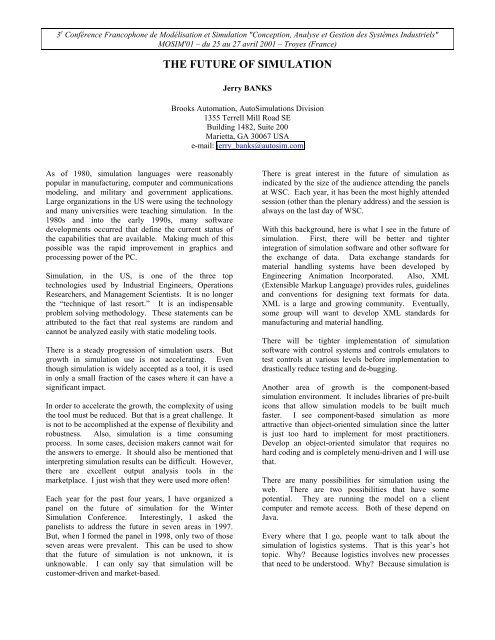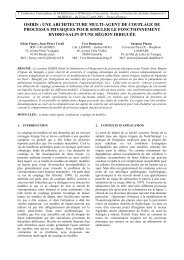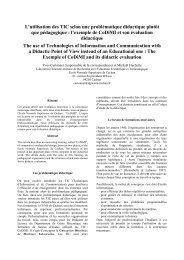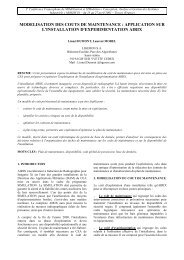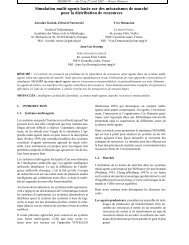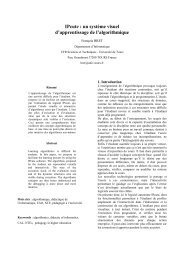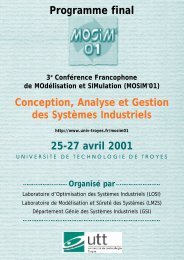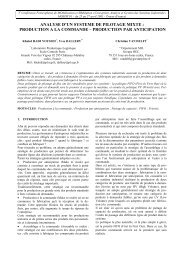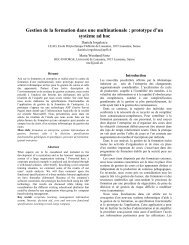THE FUTURE OF SIMULATION
THE FUTURE OF SIMULATION
THE FUTURE OF SIMULATION
You also want an ePaper? Increase the reach of your titles
YUMPU automatically turns print PDFs into web optimized ePapers that Google loves.
3 e Conférence Francophone de Modélisation et Simulation "Conception, Analyse et Gestion des Systèmes Industriels"MOSIM'01 – du 25 au 27 avril 2001 – Troyes (France)<strong>THE</strong> <strong>FUTURE</strong> <strong>OF</strong> <strong>SIMULATION</strong>Jerry BANKSBrooks Automation, AutoSimulations Division1355 Terrell Mill Road SEBuilding 1482, Suite 200Marietta, GA 30067 USAe-mail: jerry_banks@autosim.comAs of 1980, simulation languages were reasonablypopular in manufacturing, computer and communicationsmodeling, and military and government applications.Large organizations in the US were using the technologyand many universities were teaching simulation. In the1980s and into the early 1990s, many softwaredevelopments occurred that define the current status ofthe capabilities that are available. Making much of thispossible was the rapid improvement in graphics andprocessing power of the PC.Simulation, in the US, is one of the three toptechnologies used by Industrial Engineers, OperationsResearchers, and Management Scientists. It is no longerthe “technique of last resort.” It is an indispensableproblem solving methodology. These statements can beattributed to the fact that real systems are random andcannot be analyzed easily with static modeling tools.There is a steady progression of simulation users. Butgrowth in simulation use is not accelerating. Eventhough simulation is widely accepted as a tool, it is usedin only a small fraction of the cases where it can have asignificant impact.In order to accelerate the growth, the complexity of usingthe tool must be reduced. But that is a great challenge. Itis not to be accomplished at the expense of flexibility androbustness. Also, simulation is a time consumingprocess. In some cases, decision makers cannot wait forthe answers to emerge. It should also be mentioned thatinterpreting simulation results can be difficult. However,there are excellent output analysis tools in themarketplace. I just wish that they were used more often!Each year for the past four years, I have organized apanel on the future of simulation for the WinterSimulation Conference. Interestingly, I asked thepanelists to address the future in seven areas in 1997.But, when I formed the panel in 1998, only two of thoseseven areas were prevalent. This can be used to showthat the future of simulation is not unknown, it isunknowable. I can only say that simulation will becustomer-driven and market-based.There is great interest in the future of simulation asindicated by the size of the audience attending the panelsat WSC. Each year, it has been the most highly attendedsession (other than the plenary address) and the session isalways on the last day of WSC.With this background, here is what I see in the future ofsimulation. First, there will be better and tighterintegration of simulation software and other software forthe exchange of data. Data exchange standards formaterial handling systems have been developed byEngineering Animation Incorporated. Also, XML(Extensible Markup Language) provides rules, guidelinesand conventions for designing text formats for data.XML is a large and growing community. Eventually,some group will want to develop XML standards formanufacturing and material handling.There will be tighter implementation of simulationsoftware with control systems and controls emulators totest controls at various levels before implementation todrastically reduce testing and de-bugging.Another area of growth is the component-basedsimulation environment. It includes libraries of pre-builticons that allow simulation models to be built muchfaster. I see component-based simulation as moreattractive than object-oriented simulation since the latteris just too hard to implement for most practitioners.Develop an object-oriented simulator that requires nohard coding and is completely menu-driven and I will usethat.There are many possibilities for simulation using theweb. There are two possibilities that have somepotential. They are running the model on a clientcomputer and remote access. Both of these depend onJava.Every where that I go, people want to talk about thesimulation of logistics systems. That is this year’s hottopic. Why? Because logistics involves new processesthat need to be understood. Why? Because simulation is
MOSIM'01 – du 25 au 27 avril 2001 – Troyes (France)very useful in helping to understand a new system andlogistics systems are new.Simulation-based scheduling has been very profitable fora number of simulation vendors. In that case, thesimulation model is embedded. It is hidden. We need tofind more opportunities to embed simulation in software.Three years ago, optimization using genetic algorithmsand tabu search were in their infancy. Today, virtuallyall of the discrete-event simulation software sold in theUS has some form of optimization. There are still lots ofproblems associated wit its use. For example, it takes alot of time. This is a fertile area for research.There are some developments that I predict will gonowhere, at least in the simulation of manufacturing andmaterial handling systems. One of them is HLA (highlevel architecture). It’s just not worth the effort, and themodels run ever so slowly.Another area that I see as headed nowhere, at least inmanufacturing and material handling, is parallel anddistributed simulation (PADS). To properly use PADS,the model has to be dissected and partitioned to thecomputers that are being used. That is time consuming.An easier way to handle this problem is to distribute thereplications on a local network then reassemble all of theresults.Each year for the past few years I have organized a minitrack(four sessions) on the future of simulation for WSC.For WSC 2001, there is the familiar panel session thathas drawn such a large crowd. There are sessions onemulation, data exchange standards, and optimization.That should tell you something about what I see in thefuture.I have thought a lot about the next great application areafor simulation. Is it parcel and letter handling? Is ithealth care? Maybe it is pharmaceutical and chemicalmanufacturing? Perhaps it is mining and mineralprocessing. Or, is it printing and publishing? Or,perhaps we can do more with mid-sized manufacturing.You tell me and we can both become rich.Biographical SketchJerry Banks is Senior Simulation Technology Advisor,AutoSimulations, a Brooks Automation Company, intheir Atlanta, Georgia Office. He retired in June, 1999 asProfessor, School of Industrial and Systems Engineering,Georgia Institute of Technology. He is the author,co-author, or co-editor of eleven books, several chaptersin texts, and numerous technical papers. He is the editorof the Handbook of Simulation, published in 1998 byJohn Wiley. This book won the award for Excellence inEngineering Handbooks from the Professional ScholarlyPublishing Division of the Association of AmericanPublishers, Inc. He is the co-author, with John Carson,Barry Nelson, and David Nicol of Discrete-EventSystems Simulation, Third Edition, published byPrentice-Hall, Upper Saddle River, New Jersey,published in 2000. He is also author of the text GettingStarted with AutoMod published by AutoSimulationsalso in 2000. He is the co-author of Introduction toSIMAN V and CINEMA V, published by John Wiley,New York, in 1995. He is also the co-author of GettingStarted with GPSS/H, Second Edition, published byWolverine Software Corporation, Annandale, Virginia, in1995. Other titles include the co-authored textForecasting and Management of Technologypublished in 1991 and the single-authored text Principlesof Quality Control published in 1989, both by JohnWiley, New York. He was a founding partner in thesimulation-consulting firm Carson/Banks & Associates,Inc. located in Atlanta. The firm was purchased byAutoSimulations, Inc. in May of 1994. He is a fullmember of many technical societies including IIE forwhich he served eight years as that organization'srepresentative to the Board of the Winter SimulationConference, including two years as Board Chair. He isthe recipient of the INFORMS College on SimulationDistinguished Service Award for 1999 (seehttp://www.informs.org/Prizes/sim/JerryBanks1999DSAWinner.html).In summary, letting the mind wander allows for manyfuture possibilities. But, my predictive abilities have notbeen that good in the past. Don’t bet on what I am tellingyou about the future of simulation.


